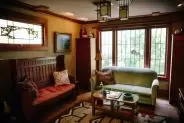The Arts & Crafts Coppersmithing Tradition
 Previously Published on Berkeleyside on August 20th, 2015
Previously Published on Berkeleyside on August 20th, 2015
Article and Photos by Melati Citrawireja
Audel Davis (pictured) and his wife, Lynne, live in a home tucked down a shady street off University Avenue. Apart from a few pesky crows that terrorize their coi fish by day, they have created a lush and quiet sanctuary, greatly influenced by the philosophy and aesthetics of the Arts and Crafts movement – a concept that took flight and reached its peak in the 1890s as a reaction to the age of mass production. It emphasized traditional craftsmanship as a way to put integrity and skill back into the design and manufacturing process.
The inside of Davis’ house is tidy and immaculate in its arrangement. In the reading room, honey-colored morning light oozes through eastern directed windows, fitted with stained-glass panes that Davis made himself.
The three of us sit at the round kitchen table as we chat. A detailed red and white piece that Lynne embroidered lays delicately across its surface, cushioning one of Davis’ copper candlesticks. Although not all of their belongings technically fit inside the time brackets of the Arts and Crafts movement, their entire home exemplifies a careful attention to craftsmanship — a reverence for handmade items and the time that is invested in making them. “It’s all consistent in terms of the process,” says Davis.
Davis is a Bay Area coppersmith, widely known for his Arts and Crafts style lamps that have his own added twist. He delved into this art after he retired from a lengthy career as a juvenile probations officer in 1989 “which was a long, long time ago,” he says, chuckling.
After spending two years in the San Francisco City College metallurgy program with loose plans to make a few light fixtures for his home, he was captivated and continued to experiment in his little home workshop. He was never very interested in money or recognition, but rather found coppersmithing a calming way to satisfy his creative itch.
After selling every piece at a show in San Francisco in the mid-1990s, “I made the mistake of agreeing to take commissions,” he says, “which I hated because people always wanted me to create things that I wasn’t interested in making. I like being able to control what I do.”
When asked what was most compelling about the Arts and Crafts movement, Davis responds: “For a lot of people they just see a style. But for serious Arts and and Crafts people, the philosophy is as interesting as the objects that are produced.”
“After World War II, modernism really took over and design concepts went through some terrible periods. Many nice things were lost because people didn’t value them as they should,” says Davis, ruefully. Then, the Arts and Crafts movement made a revival in the early 1970s after a famous exhibition at Princeton University, and the momentum was renewed for several decades.
“There really isn’t an Arts and Crafts style, but rather a process in terms of how you work — whether metal, wood, or ceramics. The designs come out of this process. Some things come out really well through the way you work the metal,” he says. Davis gestures to the first lamp he ever made, a delicately crafted but sturdy mushroom-like object sitting on a walnut dresser, with a wide rim and a rich fiery tone. The metal is specked with hundreds of individual hammer strokes.
Each lamp takes him about six weeks to complete. “It’s so fun, but very labor intensive,” he says. “It’s very satisfying to finish a piece.”
The reason Davis enjoys working with copper is because he has immense freedom in how he can manipulate both its shape and color. “Copper is a very interesting metal. It’s easy to work with and patinates beautifully — meaning you can make the surface almost any color. See this little pot here?” Davis pulls out a small pot from a wooden drawer, holding it up to the light so I can see its deep color. “I can get a really nice red if I want. Or this, this is done with liver-of-sulfur, a chemical.” He shows me another box with a mossy hue. “I use a lot of different chemicals.”
“Now the revival has peaked — in the last eight to ten years it has slowed down,” he says. “I don’t think it will completely die because it’s still as relevant now as it was in the 1800s when it really started in England. It’s just that people like things that are made by hand, not by machines.”
For more photos of Audel and his home and workshop, click here for the original post.
Audel Davis is represented by the Thomas Reynolds Gallery in San Francisco.
Melati Citrawireja, a development studies undergraduate at UC Berkeley, is currently pursuing a career in visual journalism. She was a summer 2015 photo intern at Berkeleyside. More of her work can be found online at Melati Photography.

